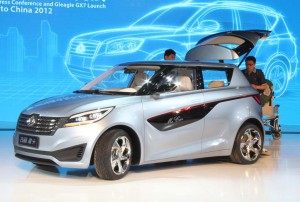It’s been the engine that helped prop up many an automaker through the industry’s recent hard times, continuing to help European manufacturers overcome their problems at home. But there are growing signs that China’s once booming auto industry is fast losing momentum – like much of the rest of that nation’s economy.
China remains the world’s largest automotive market but data released today by the China Association of Auto Manufacturers suggests it won’t even keep pace with the U.S. market this year. After an unexpected dip during the first quarter and a tepid recovery during the late spring and early summer, August automotive sales rose a meager 3.7%.
That’s well below what most analysts had been forecasting – and the equivalent of a major downturn considering that for much of the past decade China’s car market grew at well into a double-digit pace, some years topping 70%.
The picture was slightly better when commercial vehicles were added into the total, by only barely, total market demand growing by 7.8% year-over-year. That was a decline from 8% in July.
During the Beijing Motor Show, in April, most analysts said they anticipated a slowdown, though the passenger car side of the market was generally expected to still grow between 7% and 10% for the full year, according to Kevin Wale, chief executive of General Motors’ Chinese operations. But the pace since then has suggested that could prove optimistic.
The auto industry isn’t the only sector of the Chinese economy to start feeling pinched. Growth of the overall economy, in fact, fell to “just” 7.6% during the latest quarter, contributing to a general cutback in consumer spending. The numbers – which would be envied in more established markets in Europe and North America – are worrisome enough some analysts fret China could contribute to an overall global economic slide.
The situation is particularly worrisome to automakers who are trying to offset their problems in the frail European market, where overcapacity is worsening and most makers are now operating in the red.
Among those who have become increasingly dependent upon China is General Motors. The Asian market now accounts for a bigger share of unit sales than the U.S., though the home market still generates higher per-vehicle revenues and margins.
On the positive side, mainstream foreign brands, such as GM’s Buick and Chevrolet, as well as Ford and Volkswagen, are outpacing the overall Chinese market. GM posted an overall 7.3% gain last month.
That could prove critical since they’re also investing heavily based on more optimistic sales forecasts.
Ford CEO Alan Mulally, for example, late last month attended the groundbreaking for what will be the maker’s sixth Chinese assembly plant. He also revealed plans to start selling the long-struggling Lincoln brand in China, starting in 2014.
Ford can only hope that conditions improve by then. Among the brands harder hit by the current economic slowdown are luxury marques like Mercedes-Benz which earlier this year was forced to cut prices on some models by as much as 25% to maintain momentum. Cost-cutting did pay off, however, Mercedes reporting a 5% increase in August.
The biggest losers have been the Chinese domestic brands, such as Geely and BYD, the latter finding it more difficult than expected to move its various battery vehicles despite strong government support for low-emission products.
Despite the slowdown – and the fact that the U.S. posted a more than 16% jump in August new vehicle sales – China is expected to remain the world’s largest automotive market going forward. It took on that title in 2009 following a 45% year-over-year surge in sales.

